I’m hiking the Fiery Furnace Trail in Utah’s Arches National Park, and the labyrinthine slot canyons seem to stoke hikers’ imaginations. I hear questions about mountain lions, bats, rattlesnakes and scorpions. Apparently, deep, narrow canyons bring out primal fears.
But, I wonder, does anyone worry about zombies?
Yes, real-life zombies are roaming these canyons (and quite possibly, around your home). They pose no risk to humans. But their stories are mortifying, the stuff of horror movies.
Being turned into a zombie is a deeply embedded human fear, one that is currently experiencing a pop culture boost. For insects and other invertebrates, though, turning into a zombie is a very real, and highly disturbing, fate. These zombie stories also demonstrate fascinating evolution, often involving multiple and complex stages of a parasite’s life cycle.
Let’s look at some examples.
-
Horsehair Worms: Trick or Treat
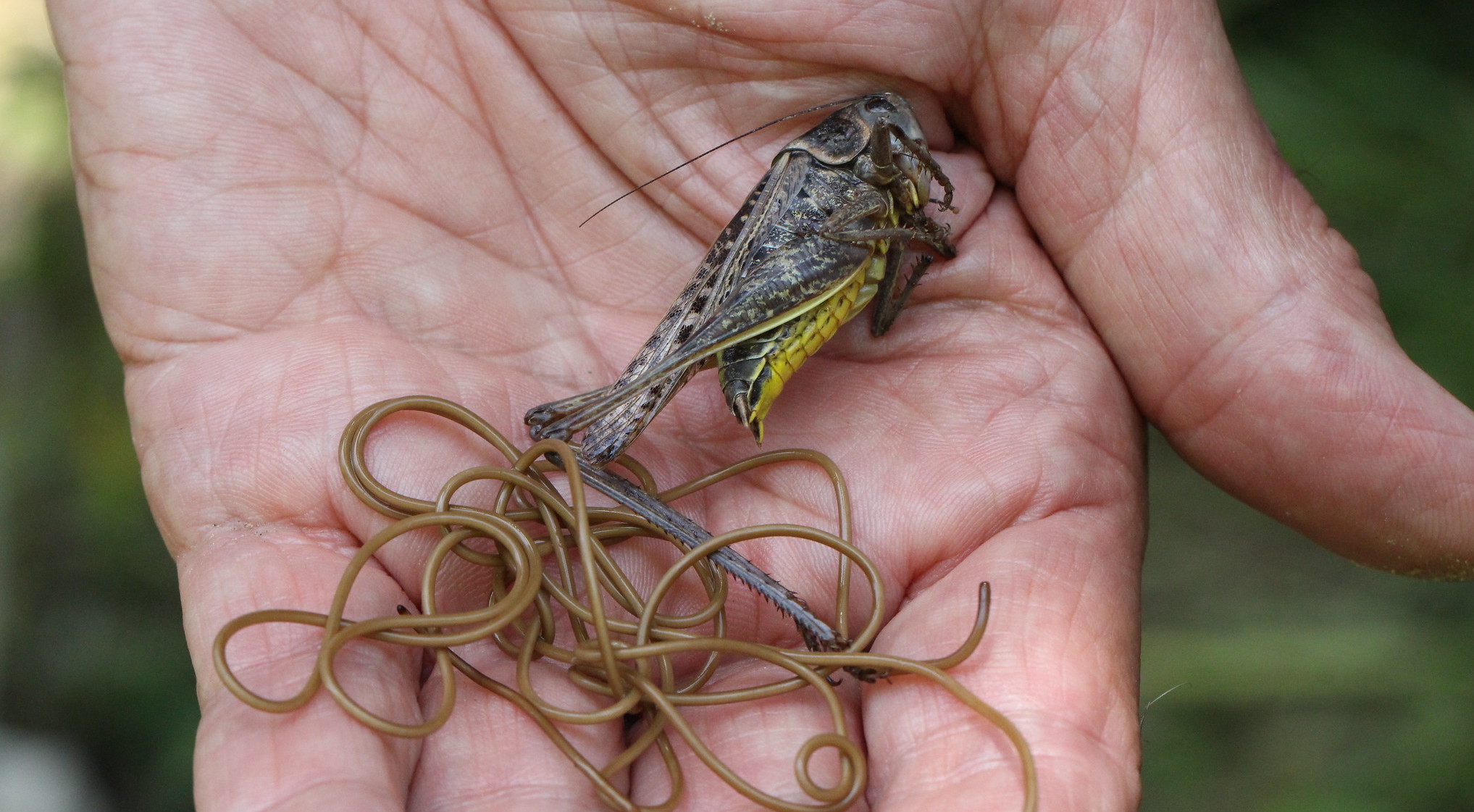
A horsehair worm and its infected host. Photo © Alastair Rae / Flickr Along trails in Utah’s canyon parks, you will often see what look like dry little bowls in the rock. These natural cisterns may not look like wildlife habitat, but in fact rangers actively try to get people not to step in them. In spring they fill with water and are home to fairy shrimp, insect larvae and creatures that resemble long, tangled strands of hair.
These are known as horsehair worms, which are not true worms but nematodes. There are more than 350 species of horsehair worms, and they can be found in many bodies of water, including rivers, streams, ponds, drying desert pools and even that puddle in your neighborhood.
That hair-like wormy critter lays a bunch of eggs in the water, which is the beginning of a very long and strange journey. The eggs hatch into larvae and float in the water column, where they resemble tasty treats for aquatic insects.
In reality, this is a rather-elaborate trick. The horsehair worm larvae is gulped by mosquito and mayfly larvae. But once in the insect’s stomach, the horsehair worm larvae encyst themselves, where they live and wait. The mayfly metamorphosizes into a flying adult, and the cyst remains.
Eventually, the insect host dies, and is fed on by a carrion eater like a cricket. Then things get really weird.
Once in the cricket’s digestive tract, the horsehair worm larva transforms into the worm – and takes control of the cricket. This “zombie cricket” does not stagger around or start randomly biting like the Walking Dead. It behaves pretty much like a normal cricket.
Except it doesn’t chirp. A chirping cricket is quite conspicuous and could attract predators. The horsehair worm needs to keep the cricket alive. For now.
However, this quickly changes if the cricket gets near water. The parasite causes the cricket to seek out and leap into water. Normally, a cricket avoids falling into water, as hungry fish await. And the cricket isn’t a great swimmer. But under control of the horsehair worm, it leaps into the water like it’s the insect version of Michael Phelps. The cricket drowns, and the horsehair worm emerges to begin the cycle anew.
-
Why Eating Bird Poop Is a Bad Idea
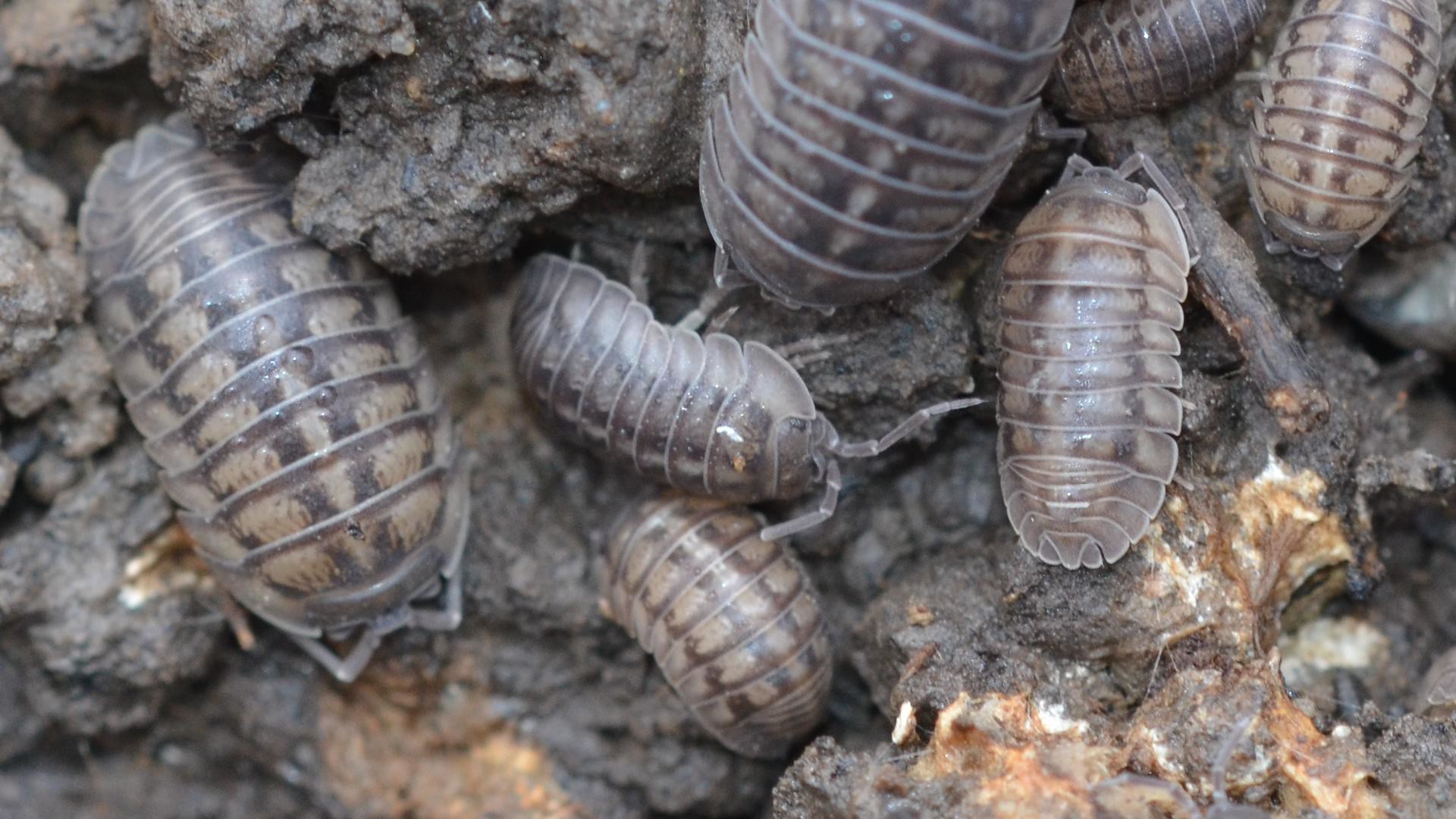
Pillbugs. Photo © Andy Reago & Chrissy McClarren / Flickr Whenever I open my compost bin, hundreds of sowbugs are scurrying around. They’re having a feast, and chicken manure from our backyard flock is part of the menu. That admittedly gross habit can also get the sowbug (also known as the roly poly or pill bug) in big trouble.
Thorny-headed worms are parasites in the digestive tracts of songbirds. Parasites must find ways to spread to continue their survival, and in many cases their eggs are passed through feces. In this case, the songbird defecates thorny-headed worm eggs. The roly poly enjoys a bird dropping dinner, and picks up the egg.
Alas, the egg transforms into a worm which turns the roly poly into a zombie. In this case, the victim does behave like a movie zombie, moving slowly and not hiding. This makes it easy prey for, you guessed it, songbirds. The bird gulps down the sowbug, and the thorny-headed worm has a new host.
-
Zombie in a Tree
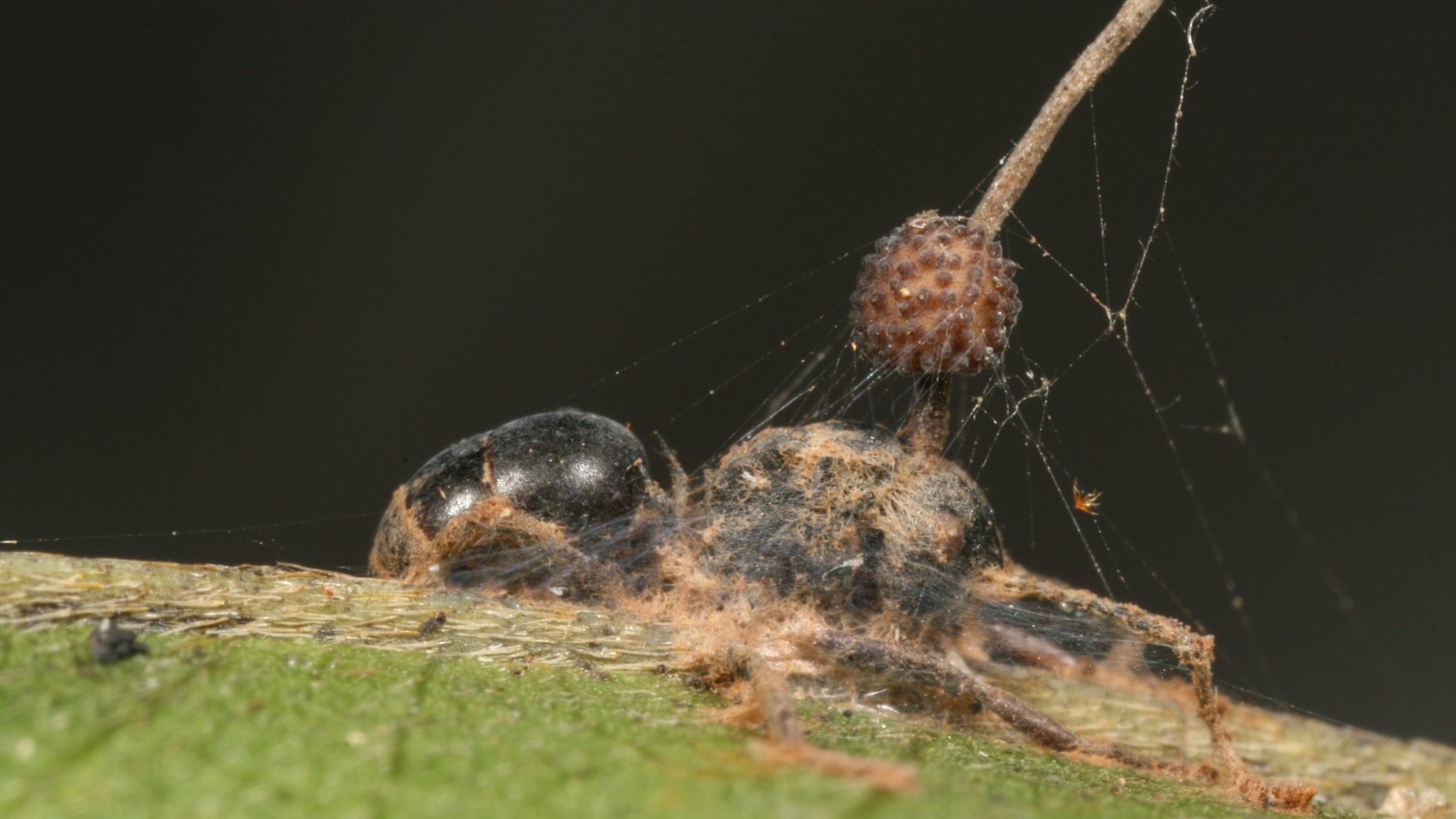
A dead carpenter ant attached to leaf in the understory of a Thai forest. Before killing the ant, the fungus growing from ant’s head changed the ant’s behavior, causing it to bite into the leaf vein. Photo © Penn State / Flickr Several species of fungi that take over the bodies of carpenter ants. The carpenter ant picks up the spore as it marches through its jungle home. The fungus will soon be in control, causing the usually social ant to break away from its colony. The ant climbs a tree, exactly 25 meters high, and clamps onto the underside of a leaf.
It will die there and the fungus will erupt from its body. Spores drop onto the forest floor below, where they will be picked up by a new wave of unsuspecting ants.
It has been widely assumed that the fungus takes over the ant’s brain. But according to The Atlantic, new research has found the fungus takes over just about everything but the brain. The fungus behaves like a colony, with individual fungal cells taking over the muscles, and cutting off connections with the brain. So the ant’s brain functions normally, but its muscles are under the control of a fungal host. Try not to put yourself in this picture.
-
Alien: Zombie Cockroach Edition
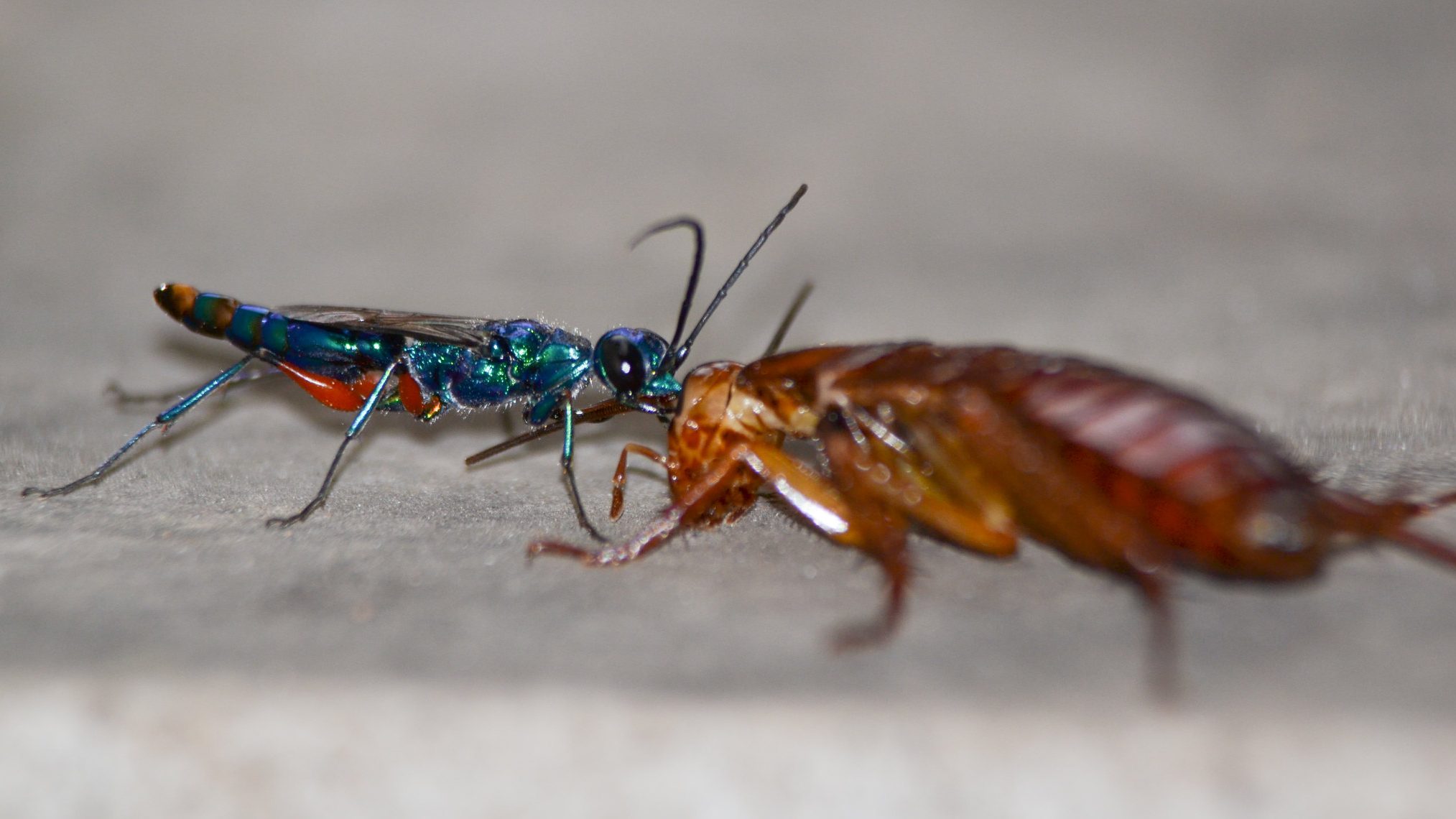
A jewel wasp dragging a cockroach. Photo © Deven Dadbhawala / Flickr It may seem difficult to pity a cockroach, let alone a zombie cockroach. But consider what happens when a cockroach meets a parasitic wasp.
There are many species of parasitic wasps, and their various parasitizing tactics reportedly inspired the Alien movies. The jewel wasp offers a particularly chilling example. When a jewel wasp’s eggs are fertilized, she needs to find one cockroach host for each egg.
A cockroach is considerably larger than a jewel wasp, and also has that tough exoskeleton. The wasp handles this by first stinging the cockroach on its abdomen, paralyzing it. Then the horror movie begins. The wasp’s next sting is a precise dose of venom to the roach’s brain.
This causes the cockroach to compulsively groom itself. It gets a jolt of dopamine, which Scientific American writer Christine Wilcox hopes makes the roach feel euphoric: “It just seems too gruesome for the animal to receive no joy from the terrible end it is about to meet.”
The wasp, out and about stinging other cockroaches, returns. The cockroach physically has the ability to walk away (or run!). But it does not. The zombie roach is under complete control of the wasp, and behaves, according to one source, “like a dog on a leash.” This is hard work for a wasp, so she pulls off the roach’s antennae and drinks the seeping liquid.
Then she leads the roach by the antennae nubs into a burrow she’s excavated. She deposits a single egg on the roach’s leg, then buries it alive with pebbles. The nightmare is far from over.
The venom keeps the roach alive and healthy by slowing its metabolism. When the young wasp hatches, it now has its first, and still fresh, cockroach dinner.
-
The Very Hungry Caterpillar Zombie
Another parasitic wasp story involves an unlucky caterpillar. In this instance, the wasp injects the caterpillar with lots of eggs. The eggs grow inside the caterpillar but do not affect its internal organs. The caterpillar, in fact, lives a normal life. However, the wasp larvae are growing, causing the caterpillar to balloon in size like the gluttonous hero of Eric Carle’s Very Hungry Caterpillar.
When the larvae mature, they climb out through the caterpillar’s skin. The larvae shed their exoskeletons on the way out, and these plug the holes in the caterpillar’s skin.
There are now a bunch of helpless larvae lying on a leaf around a caterpillar. The caterpillar could squirm away and perhaps even live. But no: the caterpillar is a zombie. It now focuses rather single-mindedly on protecting the baby wasps. It doesn’t eat. It instead uses its silk to form a protective cocoon for the larvae.
Then it stands guard. Any predator that comes near will face the zombie caterpillar’s wrath. Wired reports that the herbivorous caterpillar will even bite predators to death. As the larvae mature and are able to take care of themselves, they fly away. The caterpillar starves to death.
These examples probably don’t inspire you to start singing Circle of Life, but a diverse natural world is far more compelling (and disturbing) than a Disney movie. Creatures have evolved complex ways to survive the rigors of the world, and sometimes that means that nature is a real-life zombieland.
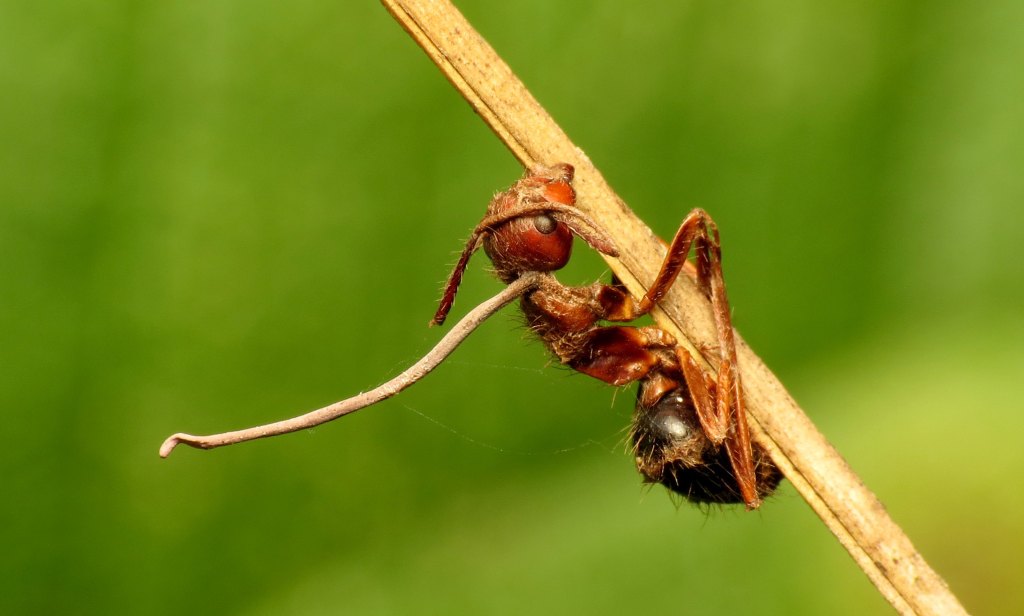



Hello
I stumbled upon Your website and started reading the article on Zombie insects. I found it intriguing and was amazed at how many different insect predators are out there, Some with heartbeats and some just blowing in the wind.
Keep up the Great work informing us about the mostly unknown world.
Thank You!!!
Bill Proscia
Great story, absolutely fascinating. I rear insects, study insects, and have experienced a lots of parasitism- but nothing like these zombie incidents.
{Is the jewel wasp a braconid?}
Another great article, Matt. Nature is intriguing. So many wasp species are parasitic on a wide assortment of other arthropods…it’s always surprising…..I have seen wasps trying to fly off with paralyzed crickets, grasshoppers, and spiders. In my local we have the tarantulas and the tarantula “hawk” (pespis wasp). Also several species of parasitic bees (often on other species of bees). and then there is the whole life cycle of gall wasp and there parasitic wasp who often has a second wasp parasite…..and on and on……..there is so much to still learn from these fascinating creatures. Thanks again for your articles.
I’ve known about parasitic wasps and various parasitic worms but have just now, learned about the Cordiceps fungi. Researched more about it. To say its activity is disturbing is an understatement ! It’s unbelievable ! My question; Does this family of fungi reside only in tropical environments, ie: Rain Forests? Have they been found in temperate climates, ie: Canada, or elsewhere in North America ? I suspect they would prefer a humid environment . . . . .
The fungus is found only in tropical areas. That said, there is a lot we don’t know about fungi (and ants), so I would not say it is impossible for there to be a similar fungus in temperate environments. Matt
Well these will stick in my mind!! Kind of gross but fascinating, too.
Loved this – especially the caterpillar. Thanks for another great article Matthew, and as a SCIFI fan appreciate the cleverness of natural things